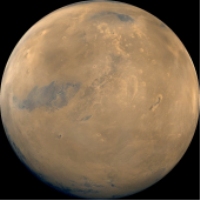
Mars, the fourth planet from the Sun, is the planet most like Earth; it is rocky with a tenuous atmosphere. However, this atmosphere is extremely thin with less than 1% of the pressure of the Earth's atmosphere. It is made up of 95.3% carbon dioxide, 2.7% nitrogen, 1.6% argon and traces of other gases. The temperature drops rapidly at night because the atmosphere is too thin to retain the daytime heat. There are polar ice caps, made mainly of frozen carbon dioxide, which advance and retreat with the seasonal changes.
The Martian surface has craters, huge dead volcanoes, sandy plains, enormous canyons, extensive areas of erosion (by wind and possibly water) and terraced areas near the poles. Nothing is liquid on Mars, though photos show channels on Mars' surface that may have been formed by running water in Mars' distant past. Mars also has the Solar System's largest known volcano, Olympus Mons which is extinct.
Rust coloured sandy desert covers much of the Martian surface, hence the name "The Red Planet". Dust storms are common, with winds of over 200 km/hr. Sometimes a big dust storm will obscure the face of the planet for months. Major surface features include a giant canyon called Valles Marineria (5 000 km long, up to 400 km wide and 7 km deep) and the massive extinct volcano Olympus Mons which is 25 km high and 600 km across at its base.
Physical Data
Diameter: 6 786 km
Surface temperature: -123 degrees Centigrade to 17 degrees Centigrade
Minimum distance from Earth: 78.3 million km
Distance from the Sun: 227.9 million km
Period of rotation: 24hr 37min
Period of orbit: 1.88 years
Number of moons: 2